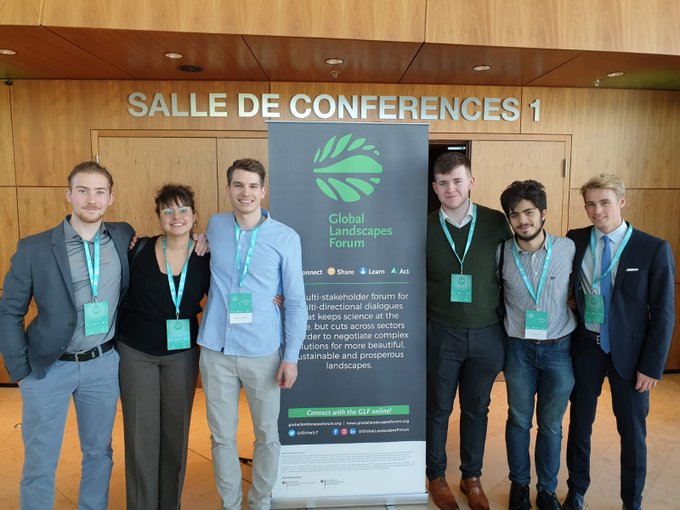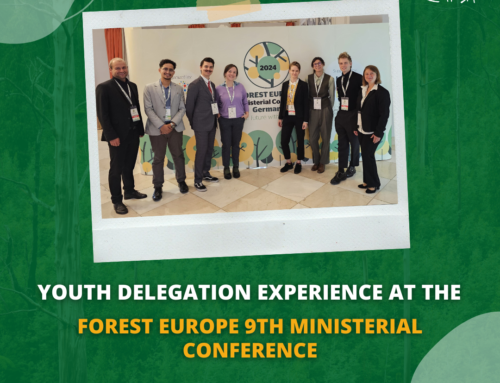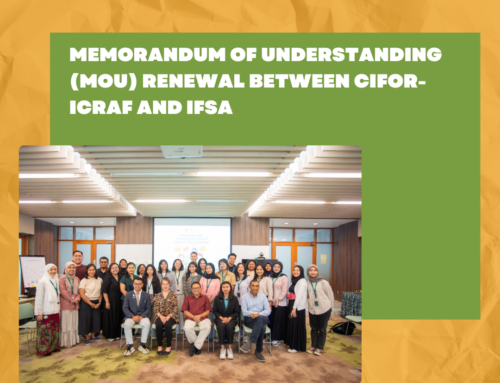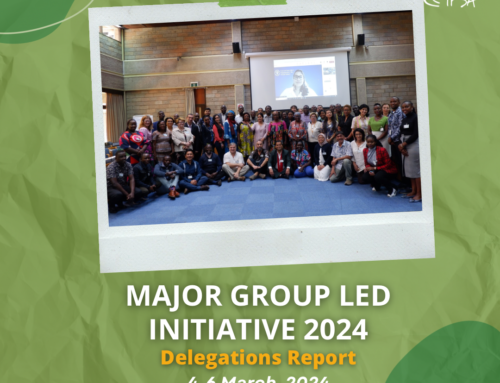From November 28th to November 30th back-to-back conferences on sustainable finance took place in Luxembourg, the UNEP FI Regional Roundtable Europe on November 28th and 29th, and the Global Landscapes Forum 4th annual Investment Case Symposium on the 30th. Additionally, the GLF organized a youth workshop on sustainable finance on November 29th.
IFSA had a delegation of 6 students in Luxembourg who attended the different events (Konstantin Schwarz, Celina Schelle, Simone Massaro, Fergus Price, Kai Thiry, David Andermahr).
UNEP Finance Initiative Regional Roundtable Europe on Sustainable Finance
(by Konstantin Schwarz – Head of UN Environment Sub-Commission)
As I was the only IFSA delegate at the event and could only attend on the 29th of November, unfortunately this report only covers the second day of the conference.
The main objective of the conference was to bring together the finance sector with politicians, researchers and practitioners from the environment and landscape sector. Discussions focused on advances in sustainable finance to address key regulatory and market challenges, the asset management industry’s role in sustainable investment, as well as how capital markets can contribute to a sustainable low-carbon economy.
As a forestry student the finance sector and concepts used can seem very complex and there was much to learn in this short time.
One of the buzzwords was surely “blended finance”, recurring during both days of conference. Blended finance describes finance models in which the risks of investment for a development/landscape project are distributed over different stakeholders, particularly with state participation (see more detailed explanation of blended finance and why it might be a solution to unlocking more private capital for the development and landscape sector here: www.blendedfinance.earth). Such schemes come as an answer to past reservations of investors towards small-scale farming and forestry projects, which were considered “unbankable” due to many risks that often are allocated unfairly. In these discussions on blended finance two implications were raised: One consequence of blended finance schemes would be more public-private partnerships, another one was the urge of private companies towards the public sector to funnel more public money into afforestation, since so far it has been really scarce.
More takeaway messages from the UNEP FI Regional Roundtable Europe included the general motivation of all stakeholders to move faster than in the past when allocating money towards forest landscape restoration (FLR) and sustainable finance projects. Additionally, there are promising pilot projects and best practices of sustainable landscape finance, but these need to be scaled up and mainstreamed. A last important outcome of the roundtable was the call for policy frameworks that are consistent with what is demanded. More specifically, it was discussed about the role of the European Union and their demand for less deforestation around the world and especially in developing countries, while countries of the EU are buying many products that come from deforestation-driving supply chains. Hence, it was raised that the actions of countries and country unions should be congruent with the right policy frameworks and that such policy frameworks should enable countries to make the right decisions and be drivers of zero net deforestation.
It was an intensive day at the UNEP FI Regional Roundtable for Europe, but also a day full of learning and hearing inspiring sessions and stories from people a forester does not get in contact with commonly. Therefore, it was all the more important that I could engage in this encounter of the public and the private, the research and the finance sector, and share my experiences with the IFSA world. Lastly, I hope this conference really was a starting point to acceleration in landscape and development finance and follows up on what it promised, and there is no loose-promise-hangover, as it has been the case after similar conferences all too often.
GLF Youth in Landscapes Sustainable Finance Workshop
(by Simone Massaro – Head of Web Sub-Commission)
On the 29th there was a workshop on sustainable Finance. We were around 40 students from all over the world ready to learn more about finance.
After the welcoming everyone we have a presentation from Cora van oosten on landscapes and landscape approach to introduce everyone to the topic and learn the main challenges related to finance.
Then we had three small from experts in the finance sector sharing their experience about sustainable landscape finance. We heard about blended finance, fundraising strategies and risk mitigation. We also had the chance to ask a lot of questions to the speakers.
After this nice introduction we started the interactive part: asking to every participant a concrete landscape to develop together a business case, then we selected five of them and divided in teams to start working on it.
First step was developing a mind map of the landscape and present it to the others.
During the afternoon we had some more presentation on Finance and on what is needed for a business plan, so we started working on our business case to develop a bankable plan in our landscape.
After we had our business case ready Salina Abraham (IFSA president for 2017/2018) did a presentation on how to do a successful pitch. Using the tips and tricks we had just learnt we developed our pitch.
Here there the five different business cases we developed during the day:
- Smart cocoa, improving cocoa farms to halt deforestation in Ghana
- Sustainable supercool coffee, ecosystem restoration with coffee production in abandoned fields in Ethiopia.
- Powercrowds, a sustainable way to provide electricity to everyone.
- Mujeres al Sol: stimulating participatory learning by local women around tourism, conservation and fuel efficient stove activities in order to decrease illegal logging, preserve habitat for monarch butterfly and economically empower women.
- Wanamei was ours: an easier, cheaper, more efficient field method for estimating the production potential of non-timber forest products in tropical rain forests, facilitating access to sustainable income sources for local communities.
In last part every team presented their business case to some potential investors, which evaluated the project. The best idea has been awarded with a huge amount of money…in chocolate coins!
The workshop was a really nice opportunity to learn important aspect about finance and how work on actual projects. Hopefully some of our ideas can have a real life impact, anyway everyone learned a lot during the workshop
Global Landscapes Forum – 4th Investment Case Symposium
(by Simone Massaro and Konstantin Schwarz)
On the 30th of November a Global Landscapes Forum took place in Luxembourg, with the focus on Finance for Sustainable Landscapes. At the conference there were more than 400 delegates both from landscapes and finance sectors as well as many youths. Moreover about 6400 people followed the conference online through the live streams.
The Opening Plenary set the tone for the day. Leading researchers, finance executives, diplomats and politicians, including Sara Löfqvist as a representative for the Youth in Landscapes initiative, joined the stage to discuss the question of how to move sustainable land use finance into the mainstream.
Important takeaway messages included that we currently are on a wave of momentum for nature based solutions to development. We are going into a “super year for nature” 2020, and after that into the UN Decade of Ecosystem Restoration, hence, there is a decade-long framework in which investments into landscape restoration should be accelerated immensely. If it is made possible by all stakeholders involved in the global landscape nexus to tackle biodiversity loss and climate change together, most of the SDGs would be covered. A very inspiring, but optimistic message.
Additionally, the urge for turning all the knowledge we have into action was raised. So much has been already researched on the subject of the landscape approach, sustainable finance and forest landscape restoration, accumulating a large amount of information. Turning this knowledge into a business case needs to be the next step.
Finally, it was brought up that change needs to start with each individual and that everyday actions are crucial to start creating a momentum shift, building another important outcome of this opening plenary.
During the day the were 12 sessions divided into 4 parallel tracks, where all the main theme about finance in landscape were discussed. Talks ranged from carbon credits market to measuring the impact on biodiversity of an investment.
The peculiarity of the conference was the presence of experts and stakeholders from all sectors: environmental organizations, finance people, investors in “green” funds, bankers, representatives from local communities projects, youth.
This made possible really have to different world meeting together and discussing a way forward together.
The last session of this GLF was the closing plenary, focused on the results of the day and the way forward in sustainable finance. For the audience the most important thing learned during the day was collaboration, which perfectly reflects of was the main goals of the conference: connecting finance and landscape sector to find together solutions economically sustainable and good for the environment. The key points from this plenary were the importance of climate change, both mitigation and adaptation; the high perceived risk in environmental investments, even if the isn’t a big real risk; the need of an updated the policy framework to allow more investments in the green sectors; partenishtps to involve all of the stakeholders. Lastly, and probably the most important outcome, is the need to act urgently and to scale up our efforts.
To discover more about the conference, here you can find the official website of the event https://events.globallandscapesforum.org/luxembourg-2019/, with the recording of many sessions and the official pictures https://www.flickr.com/photos/globallandscapesforum/albums/72157711985268797/page1





